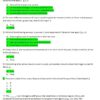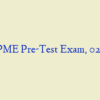Description
SEJOME Post test Exam – Question and Answers
- The Coast Guard has always served under the Secretary of the Treasury, reflecting its early historical mission.
- The statutory members of the National Security Council are _____.
- Command authority over assigned or attached forces or commands, or military capability or forces made available for tasking, that is limited to the detailed direction and control of movements or maneuvers within the operational area necessary to accomplish missions or tasks assigned is known as _____.
- Today, the U.S. and its partners find themselves in an era in which they are unlikely to be fully at war or fully at peace.
- Policy makers often fail to have a clear understanding of what the implications of their decisions will be on ground forces.
- The 193rd Special Operations Wing of the Pennsylvania Air National Guard provides the only _____ platform in the Department of Defense with the EC-130 Commando Solo.
- The United States employs its military capabilities at home and abroad in support of its national security goals in a variety of operations known in doctrine today as _____.
- The purpose of the _____ principle of joint operations is to allocate minimum essential combat power to secondary efforts.
- The President of the U.S. provides guidance for developing, applying, and coordinating the instruments of national power to achieve objectives that contribute to national security in the _____.
- The _____ is the principal forum to advise the President with respect to the integration of domestic, foreign, and military policies relating to national security and for coordinating these policies among various government agencies.
- Receiving realistic training, understanding the types of situations encountered in war, eating well, getting enough rest, and having meaningful relationships and friendships are all helpful in building _____ to the challenges and strains of military service.
- Which of the following examples embodies Navy traditions and core values of honor, courage, and commitment?
- The supported combatant commander is responsible for developing ______, which covers interagency coordination, for each operation plan (OPLAN). This enables interagency planners to more rigorously plan their efforts in concert with the military, to suggest other activities or partners that could contribute to the operation, and to better determine any support requirements they may have.
- There are a total of how many Reserve Components in the Armed Forces of the United States?
- The end strength of the U.S. Coast Guard Reserve is _____ percent of the total Coast Guard.
- The use of social media to conduct official government business is forbidden.
- Reserve Component leaders agree that they receive adequate funding to support all levels of operational use identified by Service and Department of Defense plans.
- Successful teamwork in the joint environment requires trust, confidence and _____.
- _____ and _____ are two key structural enhancements that should improve the coordination of multinational forces.
- Taking steps and precautions to reduce the likelihood of something negative or hazardous happening, or reducing the extent of the exposure to a risk, is called risk modification.
- Typical signs of _____ include headaches, memory gaps, confusion, attention problems, irritability, ringing in the ears, dizziness, nausea, fatigue, slowed reaction time, sleep difficulty, and performance difficulties.
- Historically, the practice of keeping pets onboard may have started when cats were brought onboard to combat the rat population, the practice continued to help keep the crew’s morale high.
- The primary function of the Air Force is to provide prompt and sustained offensive and defensive air operation.
- A special operations command-forward can transition to a _____.
- What is the purpose of sending someone to the Grog Bowl?
- The Joint Task Force commander facilitates unified action and gains a greater understanding of the roles of IGOs and NGOs and how they influence mission accomplishment by establishing a _____.
- Joint education can be broadly parsed into three categories: Joint Professional Military Education (JPME), Enlisted Joint Professional Military Education (EJPME), other Joint Education.
- As ratified, the U.S. Constitution provided for a small professional army supplemented a militia of all able-bodied males under strict civilian control.
- “. . . the United States Armed Forces [is] comprised of Active-duty, Reserve, and National Guard components, today’s all-volunteer” military, known as the “Total Force.” Today’s military known as the “Total Force.”
- What are the Army’s primary missions? (Select all that apply.)
- The DoD Reorganization Act of 1958 _____.
- One of NATO’s goals is to promote democratic values.
- “The Noncommissioned Officer and Petty Officer: Backbone of the Armed Forces (2013)” states that, “To be successful in building and sustaining [a solid and trustworthy] relationship with officers, NCOs/POs must be _____.”
- Factors affecting military capabilities of nations include _____.
- The difficulty some units face adapting their mindset to vastly changed conditions on their third or fourth deployment to the same location is known as _____ challenges.
- While it is appropriate and strongly recommended to greet a person by name and grade, if you are unsure of an enlisted Marine’s name or grade, “Marine” is as appropriate as, “Good morning, Sir,” in the case of an officer.
- Which of the following define the best benefits of versatility in aerospace power? (Select all that apply.)
- Which of the following is NOT one of the major levels of reserve mobilization?
- Which of the following problems faced the newly created Air Force in 1947? (Select all that apply.)
- Which of the following describes the role of the Coast Guard in the U.S.’s maritime regions?
- After the attacks of 9/11, U.S. Special Operations Command assumed an operational role in synchronizing the DoD effort in _____.
- _____ are operations require independent actions involving a high degree of professionalism, self-discipline, flexibility, patience, and tact.
- Which of the following are examples of naval implementation of the U.S. Containment Policy? (Select all that apply.)
- Upon a declaration of war the Coast Guard may be transferred to and operate as a service of the U.S. Navy?
- During the Total Force Fitness ((TFF) Program section of the course, we discussed the importance of leader involvement. Leaders must identify the metrics that will set the right conditions to promote total fitness. In order to accurately assess the TFF program’s effectiveness, metrics must be _____.
- Security cooperation activities include _____.
- Why was the participation of the Montford Point Marines in the amphibious assault at Saipan such a historic event?
- The first step in solving a problem is to _____.
- While its missions might include forcible entry operations and peace enforcement, humanitarian assistance is not within the Marine Corps’ purview.
- A group or person is honor-bound to do which of the following upon receiving a limerick at mess?
SEJOME Post Test Set 2
- Successful teamwork in the joint environment requires trust, confidence and _____.
- Which of the following are examples of naval implementation of the U.S. Containment Policy? (Select all that apply.)
- Joint force commanders coordinate with other government agencies to facilitate coherent use of all instruments of national power in achieving national strategic objectives.
- The Joint Task Force commander should carefully consider where to locate the civil-military operations center. Which of the following are valid considerations in determining the location?
- The principle of joint operations designed to ensure the commitment necessary to attain the national strategic end state is _____.
- Receiving realistic training, understanding the types of situations encountered in war, eating well, getting enough rest, and having meaningful relationships and friendships are all helpful in building _____ to the challenges and strains of military service.
- There are eight distinct domains within the Total Force Fitness (TFF) Program. This one refers to the ability to perform mission-specific duties in any environment.
- The multinational force commander must resolve or mitigate sovereignty through which of the following? (Select all that apply.)
- Which of the following define the best benefits of versatility in aerospace power? (Select all that apply.)
- The abilities of the Coast Guard to operate in severe weather conditions, 24 hours a day, year round, are called?
- Which core value does the following tenet represent: Make decisions in the best interest of the Navy and the nation, without regard to personal consequence
- The primary function of the Air Force is to provide prompt and sustained offensive and defensive air operation.
- As ratified, the U.S. Constitution provided for a small professional army supplemented a militia of all able-bodied males under strict civilian control.
- .The primary responsibilities of the Air Force Reserve Components, the Air Force Reserve, and the Air National Guard include airlift and air refueling.
- Why was the participation of the Montford Point Marines in the amphibious assault at Saipan such a historic event?
- One of the characteristics of citizens that strengthens the U.S. is _____.
- Which of the following is NOT one of the Special Operations Forces Truths?
- Leaders should look for which of the following warning signs that are suggestive of trauma spectrum disorders?
- Within joint command organizations, leadership and ethics considerations require us to _____ and consider not only personal experiences, but also the lessons learned from others’ experiences – both positive and negative.
- Deploying the U.S. Navy to stop pirates from raiding shipping lanes in the Indian Ocean would fall under which fundamental role of the National Naval Strategy? (Select all that apply.)
- Recognizing potentially hazardous or negative situations in advance is crucial to being prepared to prevent them from occurring to begin with. With experience and maturity, the ability to instinctually recognize signs of potential trouble increases.
- The operational chain of command runs directly from the President to the Secretary of Defense and then to the _____.
- While its missions might include forcible entry operations and peace enforcement, humanitarian assistance is not within the Marine Corps’ purview.
- Which of the following are expected of every Marine in battle? (Select all that apply.)
- Which of the following is a technical or personal risk when using social media?
- Reserve Component leaders believe that they receive adequate funding to support all levels of operational use identified by Service and Department of Defense plans.
- A unified or specified command with a broad continuing mission under a single commander established and so designated by the President, through the Secretary of Defense and with the advice and assistance of the Chairman of the Joint Chiefs of Staff is called a _____.
- The country team provides for rapid interagency consultation and action on recommendations from the field. The Department of Defense is normally represented on the country team by the _____ and the _____.
- What are the key criticisms of the interagency process? (Select all that apply.)
- Which of the following ceremonies affirms a “leader among leaders” in the USAF, using a symbol of truth, justice, and power rightly used?
- Under what circumstances may the Coast Guard be transferred to and operate as a service of the Navy? (Select all that apply.)
- The earliest form of the Coast Guard began on 4 August 1790, when President George Washington authorized the construction of ten vessels to _____.
- Units that support military commanders by working with civil authorities and civilian populations in the commander’s area of operations during peace, contingency operations, and war are known as _____ teams.
- The ability of the U.S. to achieve its national strategic objectives is dependent on the effectiveness of the U.S. Government in employing the instruments of national power, which are _____.
- Joint _____ provides the fundamental principles that guide the employment of U.S. military forces in coordinated action toward a common objective.
- Which branch of the armed forces operates within the Department of Homeland Security?
- After the attacks of 9/11, U.S. Special Operations Command assumed an operational role in synchronizing the DoD effort in _____.
- To promote their mutual national interests and ensure mutual security against real and perceived threats, nations that form partnerships must understand the impacts of _____.
- The comprehensive doctrine of air warfare supported the conclusion that high-altitude, daylight bombing of an enemy’s war-supporting industries and transportation systems could win a war.
- What WWII conference established the Joint Chief of Staff?
- The difficulty some units face adapting their mindset to vastly changed conditions on their third or fourth deployment to the same location is known as _____ challenges.
- To ensure that respect and mutual cooperation exists among all parties, and to leverage cooperation in order to meet operational end states, combatant commanders should use _____.
- Mutual trust and understanding is essential to mission command success.
- The Army aids in shaping the international environment through an extensive forward presence in which of the following?
- Which of the following are considerations when hosting a formal dinner?
- There are a total of how many Reserve Components in the Armed Forces of the United States?
- The _____ acts as the honest “broker” among the many U.S. Government agencies to solve disagreements and achieve consensus among agencies on national security issues.
- Which of the following honors can be bestowed upon a service member of the Coast Guard? (Select all that apply.)
- Deliberations involving the possible use of force must include the Reserve Component at what point in the planning process?
- The first step in solving a problem is to _____.
SEJOME Post Test Exam Set 3
- By 1986, the Marine prepositioning strategy had in place 13 ships: one squadron in the eastern Atlantic, a second squadron in the Indian Ocean at Diego Garcia, and a third in the western Pacific at Guam.
- Capt. Van Boskerck wrote the words to Semper Paratus while serving on board the Yamacraw in 1922.
- The following Reserve Components have both a Federal (Title 10) mission and a State (Title 32) mission, and therefore can be used to enforce State laws.
- Which of the following options represent the Statutory Advisors of the National Security Council?
- As ratified, the U.S. Constitution provided for a small professional army supplemented a militia of all able-bodied males under strict civilian control.
- The primary function of the Air Force is to provide prompt and sustained offensive and defensive air operation.
- Which of the following are keys to success in joint assignments? (Select all that apply.)
- The term _____ refers to the aggregate of features and traits that form the individual nature of a person. In the context of the profession of arms, it entails moral and ethical adherence to our values. It is at the heart of the relationship of the profession with the American people, and to each other.
- Deliberations involving the possible use of force must include the Reserve Component at what point in the planning process?
- The _____ is an integrative and holistic framework to better understand, assess, and maintain the fitness of the joint force.
- The term “scuttlebutt” is a Navy word referring to the kitchens of the ship.
- The abilities of the Coast Guard to operate in severe weather conditions, 24 hours a day, year round, are called?
- Aerospace forces produce synergistic effects through the application of a singular dominating force, without the contributions of the other Services.
- The multinational force commander must resolve or mitigate sovereignty through which of the following? (Select all that apply.)
- _____ is key to successful employment, readiness, and use of Reserve Component forces.
- If something of an ethical nature is ever in doubt, commanders should contact their legal counsel for advice.
- While it is appropriate and strongly recommended to greet a person by name and grade, if you are unsure of an enlisted Marine’s name or grade, “Marine” is as appropriate as, “Good morning, Sir,” in the case of an officer.
- Marine Corps forces exploit the Total Force concept, employing combinations of active duty and reserve Marines to ensure that missions are effectively and efficiently executed.
- Concussion is a term many service members prefer to use instead of “brain injury” when discussing head injuries (mild traumatic brain injuries or mTBI).
- A special operations command-forward can transition to a _____.
- The operational chain of command runs directly from the President to the Secretary of Defense and then to the _____.
- _____ is the process used to mitigate operational risks. Although created with military operations in mind, these procedures can be used to plan other activities.
- These capabilities comprise the core of U.S. maritime power and reflect an increase in emphasis on those activities that prevent war and build partnerships:
- _____ is a hostile environment that often presents complex emotional and ethical dilemmas.
- The _____ is written guidance from the Secretary of Defense to the Chairman of the Joint Chiefs of Staff for the preparation and review of contingency plans for specific missions. It includes the relative priority of the plans, specific force levels, and supporting resource levels. 26) Units that support military commanders by working with civil authorities and civilian populations in the commander’s area of operations during peace, contingency operations, and war are known as _____ teams.
- The most recent time the Coast Guard was called into service and deployed in wartime was?
- Under what circumstances may the Coast Guard be transferred to and operate as a service of the Navy? (Select all that apply.)
- The North American Aerospace Defense Command (NORAD) is an operated by which countries? (Select all that apply.)
- Joint _____ prepares individual members and units of the Armed Forces to field a joint force that integrates service capabilities in order to execute assigned missions.
- Which of the following ceremonies affirms a “leader among leaders” in the USAF, using a symbol of truth, justice, and power rightly used?
- What are the key criticisms of the interagency process? (Select all that apply.)
- U.S. military forces are authorized under certain conditions to provide assistance to U.S. civil authorities for disasters, catastrophes, infrastructure protection, and other emergencies. This assistance is known as ______ within the defense community because the assistance will always be in support of a lead Federal agency.
- The four categories of support are _____.
- A group or person is honor-bound to do which of the following upon receiving a limerick at mess?
- What is the Army’s primary role?
- In the Chairman’s White Paper, “Mission Command” (2012), “. . .requires leaders at every echelon to be _____.”
- To ensure that respect and mutual cooperation exists among all parties, and to leverage cooperation in order to meet operational end states, combatant commanders should use _____.
- There are a total of how many Reserve Components in the Armed Forces of the United States?
- Short-duration strikes and other small-scale offensive actions conducted with specialized military capabilities to seize, destroy, capture, exploit, recover, or damage designated targets in hostile, denied, or diplomatically and/or politically sensitive environments is called _____. It differs from other offensive actions in the level of diplomatic or political risk, the operational techniques employed, and the degree of discriminate and precise use of force to achieve specific objectives.
- The United Nations, the North Atlantic Treaty Organization (NATO), the Organization for Security and Cooperation in Europe, and the African Union are all examples of _____.
- _____ helps prevent adversary action through the presentation of a credible threat of counteraction. It stems from the belief of a potential aggressor that a credible threat of retaliation exists, the contemplated action cannot succeed, or the costs outweigh any possible gains.
- In 1798, the U.S. Navy and U.S. Marine Corps were created.
- The foremost value of joint force leaders is _____.
- The difficulty some units face adapting their mindset to vastly changed conditions on their third or fourth deployment to the same location is known as _____ challenges.
- The 1986 Goldwater-Nichols Act _____.
- Receiving realistic training, understanding the types of situations encountered in war, eating well, getting enough rest, and having meaningful relationships and friendships are all helpful in building _____ to the challenges and strains of military service.
- Which of the following were goals for the Berlin Airlift of 1948? (Select all that apply.)
- The North Atlantic Treaty Organization (NATO) is an example of a(n) _____.
- Combatant commanders and subordinate joint force commanders work with U.S. ambassadors (or diplomatic missions), Department of State, and other agencies to best integrate the military actions with the diplomatic, economic, and informational instruments of national power in order to promote _____.
SEJOME Post Test Exam 4
- The primary responsibilities of the Air Force Reserve Components, the Air Force Reserve, and the Air National Guard include airlift and air refueling.
- The National Security Council comprises of which three levels of formal interagency committees for coordination and making decision on national security issues?
- The first step in solving a problem is to _____.
- Which of the following are among the Coast Guard’s roles? (Select all that apply.)
- When employing local national support, appropriate security measures should be taken to _____.
- Reserve Component leaders believe that they receive adequate funding to support all levels of operational use identified by Service and Department of Defense plans.
- The _____ is the primary vehicle through which the Chairman of the Joint Chiefs of Staff (CJCS) exercises responsibility to provide for the preparation of joint operation plans. It provides guidance and direction from the CJCS to the combatant commanders and the Service chiefs for preparation of contingency plans.
- Upon a declaration of war the Coast Guard may be transferred to and operate as a service of the U.S. Navy?
- Guidance from which joint operations are planned and executed is obtained from joint _____.
- Which of the following is not considered an instrument of national power?
- U.S. Africa Command, U.S. Central Command, U.S. European Command, U.S. Northern Command, U.S. Pacific Command, and U.S. Southern Command constitute the _____.
- Because not every nation will agree with proposed coalition actions, what is an acceptable work-arounds to accomplish the mission without offending other nations?
- In most situations, intergovernmental organizations and nongovernmental organizations need the following military capabilities:
- Through which of the following strategies has the Navy adopted, which advanced the concept of combat operations in littoral waters?
- The comprehensive doctrine of air warfare supported the conclusion that high-altitude, daylight bombing of an enemy’s war-supporting industries and transportation systems could win a war.







